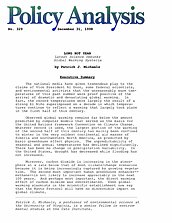Observed global warming remains far below the amount predicted by computer models that served as the basis for the United Nations Framework Convention on Climate Change. Whatever record is used, the largest portion of the warming of the second half of this century has mainly been confined to winter in the very coldest continental air masses of Siberia and northwestern North America, as predicted by basic greenhouse effect physics. The unpredictability of seasonal and annual temperatures has declined significantly. There has been no change in precipitation variability. In the United States, drought has decreased while flooding has not increased.
Moreover, carbon dioxide is increasing in the atmosphere at a rate below that of most climate-change scenarios because it is being increasingly captured by growing vegetation. The second most important human greenhouse enhancer — methane — is not likely to increase appreciably in the next 100 years. And perhaps most important, the direct warming effect of carbon dioxide was overestimated. Even global warming alarmists in the scientific establishment now say that the Kyoto Protocol will have no discernible impact on global climate.


